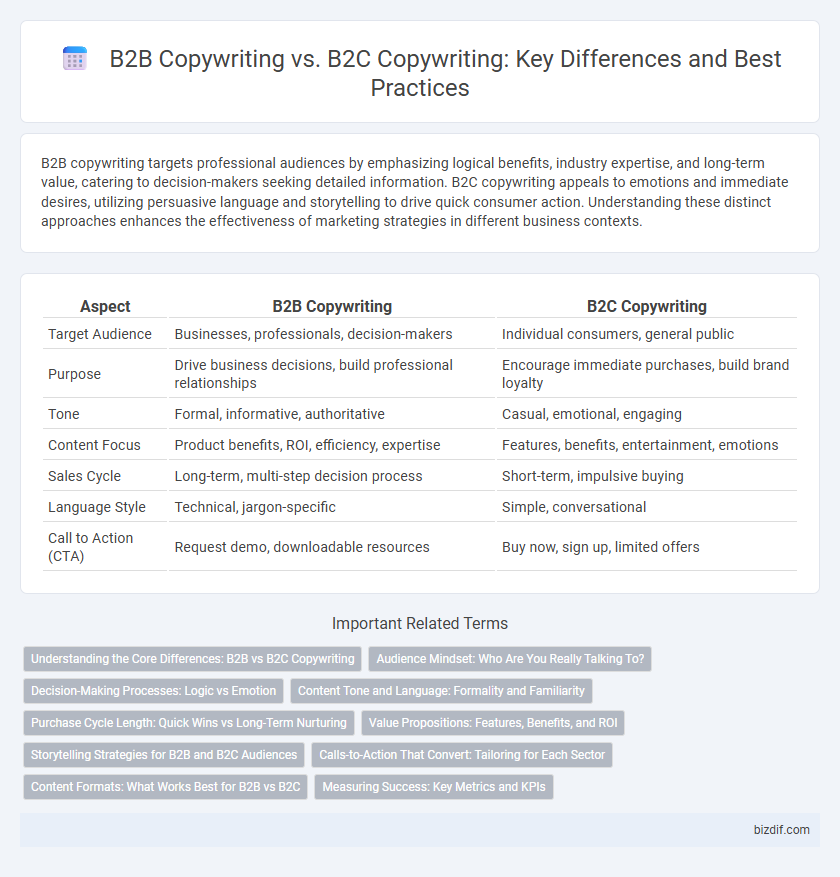B2B copywriting targets professional audiences by emphasizing logical benefits, industry expertise, and long-term value, catering to decision-makers seeking detailed information. B2C copywriting appeals to emotions and immediate desires, utilizing persuasive language and storytelling to drive quick consumer action. Understanding these distinct approaches enhances the effectiveness of marketing strategies in different business contexts.
Table of Comparison
| Aspect | B2B Copywriting | B2C Copywriting |
|---|---|---|
| Target Audience | Businesses, professionals, decision-makers | Individual consumers, general public |
| Purpose | Drive business decisions, build professional relationships | Encourage immediate purchases, build brand loyalty |
| Tone | Formal, informative, authoritative | Casual, emotional, engaging |
| Content Focus | Product benefits, ROI, efficiency, expertise | Features, benefits, entertainment, emotions |
| Sales Cycle | Long-term, multi-step decision process | Short-term, impulsive buying |
| Language Style | Technical, jargon-specific | Simple, conversational |
| Call to Action (CTA) | Request demo, downloadable resources | Buy now, sign up, limited offers |
Understanding the Core Differences: B2B vs B2C Copywriting
B2B copywriting targets professional audiences by emphasizing logical benefits, detailed product features, and return on investment, whereas B2C copywriting appeals to emotional triggers, personal desires, and quick gratification. B2B content often involves longer sales cycles and requires authority-building through case studies, whitepapers, and data-driven insights, while B2C relies on catchy headlines, storytelling, and emotional engagement to drive immediate action. Understanding these core differences ensures tailored messaging that meets the distinct needs and decision-making processes of business clients versus individual consumers.
Audience Mindset: Who Are You Really Talking To?
B2B copywriting targets professionals seeking solutions to improve business performance, emphasizing clear ROI, industry expertise, and long-term relationships. B2C copywriting appeals directly to individual consumers driven by emotion, personal benefit, and immediate gratification. Understanding these distinct audience mindsets ensures tailored messaging that resonates effectively and drives engagement.
Decision-Making Processes: Logic vs Emotion
B2B copywriting emphasizes logical decision-making by highlighting product features, ROI, and industry-specific benefits to appeal to professional buyers. B2C copywriting leverages emotional triggers, storytelling, and brand sentiment to influence consumer purchasing behavior. Understanding the distinction between B2B's data-driven approach and B2C's emotion-driven strategy is essential for crafting effective marketing messages.
Content Tone and Language: Formality and Familiarity
B2B copywriting typically employs a formal tone with industry-specific language to build credibility and trust among professional audiences, emphasizing logic and detailed information. In contrast, B2C copywriting adopts a more familiar, conversational style designed to evoke emotions and connect personally with individual consumers. Tailoring formality and language to the target audience enhances engagement and drives desired actions in both B2B and B2C marketing strategies.
Purchase Cycle Length: Quick Wins vs Long-Term Nurturing
B2B copywriting requires crafting detailed, informative content that supports a longer purchase cycle by addressing complex decision-making processes and multiple stakeholders. B2C copywriting targets faster purchase decisions, emphasizing emotional triggers and immediate benefits to drive quick conversions. Tailoring copy to match the purchase cycle length is essential for maximizing engagement and sales effectiveness in each market.
Value Propositions: Features, Benefits, and ROI
B2B copywriting emphasizes clear value propositions by highlighting detailed features, tangible benefits, and measurable ROI to address logical decision-making processes. B2C copywriting centers on emotional appeal, showcasing benefits that resonate personally while simplifying features for quick comprehension. Understanding these distinctions ensures tailored messaging that drives engagement and conversions in respective markets.
Storytelling Strategies for B2B and B2C Audiences
B2B copywriting leverages storytelling strategies that emphasize data-driven results, industry expertise, and problem-solving narratives tailored to decision-makers, fostering trust and credibility. In contrast, B2C copywriting uses emotional storytelling, relatable scenarios, and brand personality to engage consumers on a personal level, driving impulse buys and loyalty. Effective storytelling in both contexts hinges on understanding audience motivations and crafting messages that resonate with their unique needs and decision processes.
Calls-to-Action That Convert: Tailoring for Each Sector
B2B copywriting demands calls-to-action that emphasize relationship-building and long-term value, often using professional language and data-driven appeals suited for business decision-makers. B2C copywriting favors emotionally compelling, immediate CTAs that tap into personal desires and pain points, encouraging quick purchase decisions. Tailoring CTAs to align with the distinct buyer journeys in B2B and B2C sectors significantly boosts conversion rates and engagement.
Content Formats: What Works Best for B2B vs B2C
B2B copywriting thrives with formats such as whitepapers, case studies, and detailed blog posts that emphasize expertise and ROI, addressing complex decision-making processes. B2C copywriting favors engaging formats like social media posts, short videos, and email newsletters, designed to capture immediate interest and drive emotional responses. Understanding these format preferences enhances targeted communication strategies and improves conversion rates for each audience.
Measuring Success: Key Metrics and KPIs
Measuring success in B2B copywriting hinges on metrics like lead generation rates, conversion funnels, and customer acquisition cost, reflecting longer sales cycles and relationship-driven purchasing. In B2C copywriting, key performance indicators focus on engagement rates, click-through rates, and impulse purchases, emphasizing immediate consumer behavior and emotional appeal. Optimizing copy for these distinct KPIs ensures targeted messaging effectiveness in both B2B and B2C marketing strategies.
B2B Copywriting vs B2C Copywriting Infographic

 bizdif.com
bizdif.com